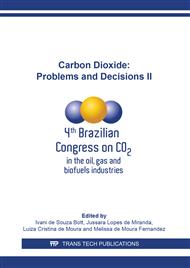[1]
M.M.L. Reis, W.L.R Gallo, Study of waste heat recovery potential and optimization of the power production by an organic rankine cycle in an FPSO unit, Energy Conversion and Management, 157 (2018), 409-422.
DOI: 10.1016/j.enconman.2017.12.015
Google Scholar
[2]
Pré-Sal Petróleo S.A. (PPSA), PPSA's roles and activities in the Brazilian Pre-Salt (2015).
Google Scholar
[3]
T.V. Nguyen, L. Tock, P. Breuhaus, F. Maréchal, B. Elmegaard, Oil and gas platforms with steam bottoming cycles: system integration and thermoenvironomic evaluation, Applied Energy, 131 (2014), 222-237.
DOI: 10.1016/j.apenergy.2014.06.034
Google Scholar
[4]
M.J. Mazzetti, P. Nekså, H.T. Walnum, A.K.T. Hemmingsen, Energy-efficient technologies for reduction of offshore CO2 emmissions, Society of Petroleum Engineers, Oil and Gas Facilities, 3 (2014), 89-96.
DOI: 10.2118/169811-pa
Google Scholar
[5]
J.D. Bimüller, L.O. Nord, Process Simulation and Plant Layout of a Combined Cycle Gas Turbine for Offshore Oil and Gas Installations, Journal of Power Technologies, 95(1) (2015), 40-47.
Google Scholar
[6]
H.T. Walnum, P. Nekså, L.O. Nord, T. Andresen, Modelling and simulation of CO2 (carbon dioxide) bottoming cycles for offshore oil and gas installations at design and off-design conditions, Energy, 54 (2013), 513-520.
DOI: 10.1016/j.energy.2013.06.071
Google Scholar
[7]
L.O. Nord, O. Bolland, Steam Bottoming Cycles Offshore - Challenges and Possibilities, Journal of Power Technologies, 92(3) (2012), 201-207.
Google Scholar
[8]
O.Q.F. Araújo, A.C. Reis, J.L. De Medeiros, J.F. Do Nascimento, W.M. Grava, A.P.S. Musse, Comparative analysis of separation technologies for processing carbon dioxide rich natural gas in ultra-deepwater oil fields, Journal of Cleaner Production, 155 (2017), 12-22.
DOI: 10.1016/j.jclepro.2016.06.073
Google Scholar
[9]
T. Malone, V. Kuuskraa, P. Dipietro, CO2-EOR Resource Assessment, DOE/NETL-2014/1631, DOE Contract Number DE-FE0004001 (2014).
Google Scholar
[10]
O.Q.F. Araújo, J.L. De Medeiros, Carbon Capture and Storage Technologies: Present Scenario and Drivers of Innovation, Current Opinion in Chemical Engineering, 17 (2017), 22-34.
DOI: 10.1016/j.coche.2017.05.004
Google Scholar
[11]
A. Al-Mamoori, A. Krishnamurthy, A.A. Rownaghi, F. Rezaei, Carbon capture and utilization update, Energy Technology: generation, conversion, storage, distribution, 5 (2017), 834-849.
DOI: 10.1002/ente.201600747
Google Scholar
[12]
T.V. Nguyen, L. Tock, L., P. Breuhaus, F. Maréchal, B. Elmegaard, CO2-mitigation options for the offshore oil and gas sector, Applied Energy, 161 (2016), 673-694.
DOI: 10.1016/j.apenergy.2015.09.088
Google Scholar
[13]
D.P. Schrag, Storage of carbon dioxide in offshore sediments, Science. 325 (2009), 1658-1659.
DOI: 10.1126/science.1175750
Google Scholar
[14]
F. Closmann, T. Nguyen, G.T. Rochelle, MDEA/Piperazine as a Solvent for CO2 Capture, Energy Procedia, 1 (2009), 1351-1357.
DOI: 10.1016/j.egypro.2009.01.177
Google Scholar
[15]
E. Følgesvold, H.S. Skjefstad, L. Riboldi, L.O. Nord, Combined heat and power plant on offshore oil and gas installations, Journal of Power Technologies, 97(2) (2017), 117-126.
Google Scholar
[16]
L.O. Arinelli, T.A.F. Trotta, A.M. Teixeira, J.L. De Medeiros, O.Q.F. Araújo, Offshore processing of CO2 rich natural gas with supersonic separator versus conventional routes, Journal of Natural Gas Science and Engineering, 46 (2017), 199-221.
DOI: 10.1016/j.jngse.2017.07.010
Google Scholar
[17]
Instituto Brasileiro do Meio Ambiente e dos Recursos Naturais Renováveis (IBAMA), Operation License No. 1397/2017 (2017).
DOI: 10.11606/d.8.2016.tde-15012016-120051
Google Scholar
[18]
H.A. Saddiq, S. Perry, S.F. Ndagana, A. Mohammed, Modelling of gas turbine and gas turbine exhaust and its utilisation as combined cycle in utility system, International Journal of Scientific & Engineering Research, 6 (2015), 925-933.
Google Scholar
[19]
H.M. Kvamsdal, J. Hetland, G. Haugen, H.F. Svendsen, F. Major, V. Karstad, G. Tjellander, Maintaining a neutral water balance in a 450 MWe NGCC–CCS power system with post-combustion carbon dioxide capture aimed at offshore operation, International Journal of Greenhouse Gas Control, 4 (2010), 613–622.
DOI: 10.1016/j.ijggc.2010.01.002
Google Scholar
[20]
Ø. Flatebø, Off-design simulation of offshore combined cycles, M.Sc. Thesis, NTNU (2012).
Google Scholar
[21]
E. De Visser, C. Hendriks, Towards hydrogen and electricity production with carbon dioxide capture and storage, D.3.1.3., DYNAMICS CO2 Quality Recommendations (2007).
Google Scholar
[22]
M.A. Cruz, O.Q.F Araujo, J.L. de Medeiros, Deep seawater intake for primary cooling in tropical offshore processing of natural gas with high carbon dioxide content: Energy, emissions and economic assessments, Journal of Natural Gas Science and Engineering, 56 (2018), 193-211.
DOI: 10.1016/j.jngse.2018.06.011
Google Scholar
[23]
S.A Freeman, R.D Dugas, H.V. Wangener, G.T. Rochelle, Carbon Dioxide Capture with Concentrated, Aqueous Piperazine, International Journal of Greenhouse Gas Control, 4 (2010), 119–124.
DOI: 10.1016/j.ijggc.2009.10.008
Google Scholar
[24]
C. Branan, Rules of Thumb for Chemical Engineers: A manual of quick, accurate solutions to everyday process engineering problems, fourth ed., Elsevier, Burlington, (2005).
Google Scholar
[25]
R. Turton, R.C. Bailie, W.B. Whiting, J.A. Shaeiwitz, Analysis, synthesis and design of chemical processes, fourth ed., Prentice Hall, New Jersey, (2012).
Google Scholar
[26]
W.L.R. Gallo, A.G. Gallego, V.L. Acebedo, R. Dias, H.Y. Ortiz, B.A. Valente, Exergy analysis of the compression systems and its prime movers for a FPSO unit, Journal of Natural Gas Science and Engineering, 44 (2017), 287-298.
DOI: 10.1016/j.jngse.2017.04.023
Google Scholar
[27]
GE POWER, Aeroderivate LM2500 gas turbine (50 Hz) – Fact Sheet (2016).
Google Scholar
[28]
L.O. Nord, O. Bolland, Design and off-design simulations of combined cycles for offshore oil and gas installations, Applied Thermal Engineering, 5 (2013), 85-91.
DOI: 10.1016/j.applthermaleng.2013.01.022
Google Scholar
[29]
Siemens, SST-600 Industrial Steam Turbines: Up to 100 MW (2008).
Google Scholar


